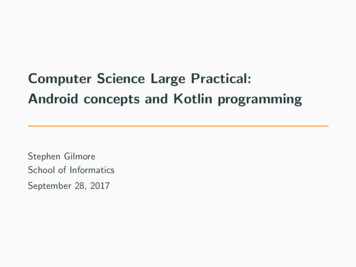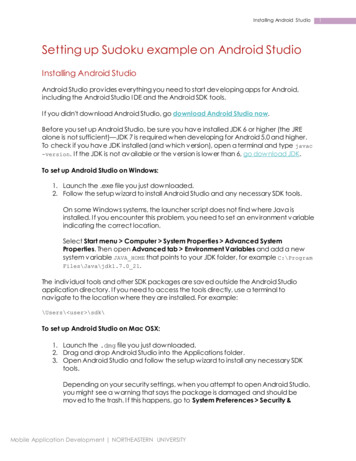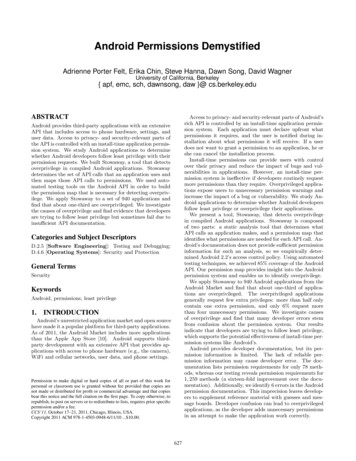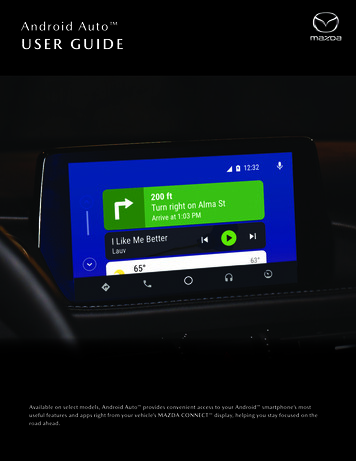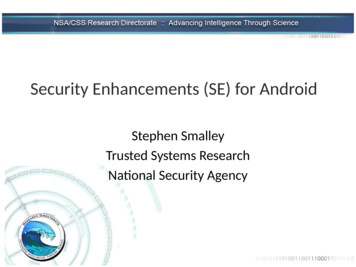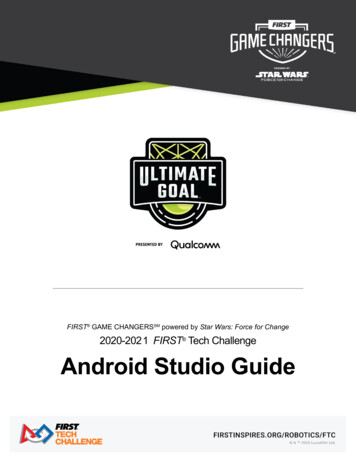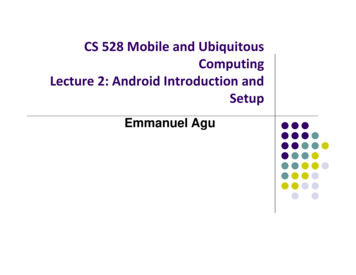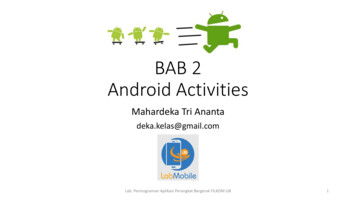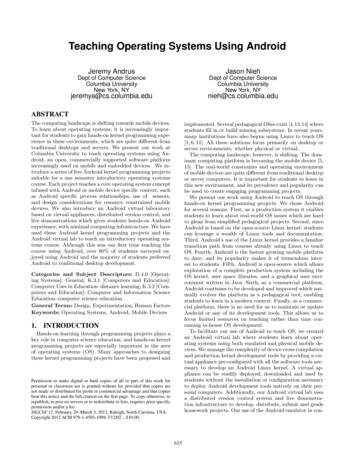
Transcription
Teaching Operating Systems Using AndroidJeremy AndrusJason NiehDept of Computer ScienceColumbia UniversityNew York, NYDept of Computer ScienceColumbia UniversityNew York, ACTThe computing landscape is shifting towards mobile devices.To learn about operating systems, it is increasingly important for students to gain hands-on kernel programming experience in these environments, which are quite different fromtraditional desktops and servers. We present our work atColumbia University to teach operating systems using Android, an open, commercially supported software platformincreasingly used on mobile and embedded devices. We introduce a series of five Android kernel programming projectssuitable for a one semester introductory operating systemscourse. Each project teaches a core operating system conceptinfused with Android or mobile device specific context, suchas Android specific process relationships, use of sensors,and design considerations for resource constrained mobiledevices. We also introduce an Android virtual laboratorybased on virtual appliances, distributed version control, andlive demonstrations which gives students hands-on Androidexperience, with minimal computing infrastructure. We haveused these Android kernel programming projects and theAndroid virtual lab to teach an introductory operating systems course. Although this was our first time teaching thecourse using Android, over 80% of students surveyed enjoyed using Android and the majority of students preferredAndroid to traditional desktop development.implemented. Several pedagogical OSes exist [4,13,14] wherestudents fill in or build missing subsystems. In recent years,many institutions have also begun using Linux to teach OS[1, 6, 11]. All these solutions focus primarily on desktop orserver environments, whether physical or virtual.The computing landscape, however, is shifting. The dominant computing platform is becoming the mobile device [5,15]. The real-world constraints and operating environmentof mobile devices are quite different from traditional desktopor server computers. It is important for students to learn inthis new environment, and its prevalence and popularity canbe used to create engaging programming projects.We present our work using Android to teach OS throughhands-on kernel programming projects. We chose Androidfor several reasons. First, as a production system it enablesstudents to learn about real-world OS issues which are hardto glean from simplified pedagogical projects. Second, sinceAndroid is based on the open-source Linux kernel, studentscan leverage a wealth of Linux tools and documentation.Third, Android’s use of the Linux kernel provides a familiartransition path from courses already using Linux to teachOS. Fourth, Android is the fastest growing mobile platformto date, and its popularity makes it of tremendous interest to students. Fifth, Android is open-source which allowsexploration of a complete production system including theOS kernel, user space libraries, and a graphical user environment written in Java. Sixth, as a commercial platform,Android continues to be developed and improved which naturally evolves the platform as a pedagogical tool, enablingstudents to learn in a modern context. Finally, as a commercial platform, there is no need for us to maintain or updateAndroid or any of its development tools. This allows us tofocus limited resources on teaching rather than time consuming in-house OS development.To facilitate our use of Android to teach OS, we createdan Android virtual lab where students learn about operating systems using both emulated and physical mobile devices. We manage the complexity of device cross-compilationand production kernel development tools by providing a virtual appliance pre-configured with all the software tools necessary to develop an Android Linux kernel. A virtual appliance can be readily deployed, downloaded and used bystudents without the installation or configuration necessaryto deploy Android development tools natively on their personal computers. Additionally, our Android virtual lab usesa distributed version control system and live demonstration infrastructure to develop, distribute, submit and gradehomework projects. Our use of the Android emulator in con-Categories and Subject Descriptors: D.4.0 [Operating Systems]: General; K.3.1 [Computers and Education]:Computer Uses in Education–distance learning; K.3.2 [Computers and Education]: Computer and Information ScienceEducation–computer science educationGeneral Terms: Design, Experimentation, Human FactorsKeywords: Operating Systems, Android, Mobile Devices1.INTRODUCTIONHands-on learning through programming projects plays akey role in computer science education, and hands-on kernelprogramming projects are especially important in the areaof operating systems (OS). Many approaches to designingthese kernel programming projects have been proposed andPermission to make digital or hard copies of all or part of this work forpersonal or classroom use is granted without fee provided that copies arenot made or distributed for profit or commercial advantage and that copiesbear this notice and the full citation on the first page. To copy otherwise, torepublish, to post on servers or to redistribute to lists, requires prior specificpermission and/or a fee.SIGCSE’12, February 29–March 3, 2012, Raleigh, North Carolina, USA.Copyright 2012 ACM 978-1-4503-1098-7/12/02 . 10.00.613
junction with this infrastructure allows remote and distancelearning students to take full advantage of our Android virtual lab, while also facilitating close collaboration with oncampus students using physical mobile devices.Students work in groups to complete five Android Linuxkernel programming projects. These projects require students to read and understand core Android Linux components, and then either modify or add components as required. The projects build in complexity, and cover various important OS topics: (1) system calls and process basedon the unique process hierarchy of an Android device, (2)synchronization where a global resource such as the orientation sensor is shared amongst many processes, (3) scheduling by exploiting Android’s single-application usage modelto increase device responsiveness, (4) virtual memory andthe exact size and nature of Android’s inter-process sharedmemory, and (5) file systems with automatic geo-tagging.We successfully used Android in a 100 student introductory OS course at Columbia University. Over 80% of students surveyed enjoyed applying OS concepts to the Androidplatform, and the majority of students preferred Androidover traditional desktop development.2.both the tools and the Android user space. Customizingthe Android user space allows us to create more engagingprojects as well as to overcome deficiencies in developmenttools. We use a customized version of the Android emulatorwhich enables students to use the Sensor Simulator programfrom OpenIntents [12] to inject orientation and accelerationdata into the emulator by interacting with a 3D model ofa phone instead of manually entering numbers into a shellprompt. We also use a custom device drawing library to support the kernel scheduling project described in Section 3.3.To manage homework project preparation, distribution,submission and grading, we use the Git distributed version control system, already used by Android and Linuxfor source code version control. Each homework assignmentconsists of a single Git repository that typically contains acomplete Linux kernel tree, template user-space projects asnecessary, any additional tools needed to complete the assignment, and a Makefile used to prepare the student’s emulator or device for project development. Instructional staffprepare each project repository and push it to a central Gitserver. The repository is then replicated such that all student groups are given access to their own private repositoryon the Git server. The central Git server also facilitates distributed group collaboration even when one or more studentsare remote or distance learning students.To maximize grading efficiency, we extend the previouslydeveloped concept of live demonstrations [7]. Three or fourstudent groups are assigned an hour long demo time slot.During the first 20-30 minutes, all student groups performa complete clone of their homework submission Git repository, cross-compile the Linux kernel for their mobile device, and install and boot the new kernel. In the last 30-40minutes, the staff meets individually with each group. During this time, groups demonstrate functionality required bythe homework, further explain their solution methodology,and participate in a basic code review. This time helps instructional staff to better understand the group’s submission, correct common mistakes, and see how group memberscontributed to an assignment. Live demos also provide opportunities for instructional staff to explain solutions whichcan facilitate a more complete understanding of difficult andchallenging assignments.Our Android virtual lab is designed to support remote ordistance learning students, though such students may onlyhave access to the emulator and not a real Android device.These students can still participate in demonstrations usingfreely available screen-sharing applications such as Skype,join.me or VNC.ANDROID VIRTUAL LABCentral to any OS development lab is universal access toproper development tools for all students. Our Android virtual lab provides each student with a pre-configured VMwarevirtual appliance containing all the Android and Linux development tools necessary to complete each programmingproject. The set of tools includes all tools necessary to bootand test a real device as well as the Android SDK comprising the Android emulator, a tool to create virtual devices, and a device debug GUI tool. We also include a crosscompilation toolchain, Android’s Bionic C library, and several shell scripts to mitigate the complexity of embeddeddevelopment.Although Android development tools are available for awide variety of platforms, we provide a pre-configured virtual appliance for four important reasons. First, we avoidmistakes or incompatibilities in development tool installation. For example, when the course was offered, the Android development tools did not support Mac OS 10.6, MacOS versions prior to 10.4, or Linux distributions other thanUbuntu. Students may also use non-standard PC configurations which would put unnecessary management burdenon the instructional staff. Second, the virtual appliance canbe used as a safety net for students who corrupt their development tool installation or experience complete systemfailure. The VMware Workstation snapshot feature can beused to make incremental backups of student work and anychanges they make to the development environment. A snapshot is also an easy way for students to begin a homeworkassignment from a known good configuration. Third, by preconfiguring all of the development tools, we avoid complicated cross-compilation setup by providing simple, standardMakefiles and shell scripts for both kernel and user-level development. The Android SDK is designed primarily for GUIapplication development not kernel development, so someconfiguration of the compiler and Android runtime librariesis necessary. A standardized environment allows us to provide simple Makefile examples for user-level test programsand simple Linux kernel cross-compilation instructions. Finally, the virtual appliance gives us freedom to customize3.KERNEL PROJECTSUsing our Android virtual lab, students work in groups tocomplete five kernel programming projects. These projectsrequire students to read, understand, and modify core Linuxcomponents. While some projects require writing a simpleuser space test program, students are never required to compile the entire Android code base or write any GUI applications. The five projects focus on five important OS concepts, and infuse Android or mobile device specific investigation into the assignment. The five areas covered by the assignments are: system calls and processes, synchronization,scheduling, virtual memory, and file systems. Corresponding Android-related topics incorporated in these areas are:the zygote process and Java worker threads, device sensors,614
display-prioritized scheduling, multi-process working set viacopy-on-write shared memory, and location aware file systems.The assignments progress in complexity, building not onlyon OS principles learned in earlier assignments, but also onAndroid specific knowledge gained. For example, the firstassignment requires students to investigate the Android process tree and note how all GUI programs are children of aprocess named zygote. In a subsequent homework, they investigate the cross-process memory sharing method used bythe zygote to save system RAM. We formalize each project’sAndroid and mobile device investigation by asking studentsto answer a small number of questions designed to makethem reflect on how the particular OS concept was appliedin the context of an Android or mobile device.All assignments are intended to keep students focused onthe OS principles being taught, and designed such that agroup of two or three students can complete them withno prior kernel or Android experience. We provide detailedstep-by-step instructions on cross-compiling and device oremulator use. Android specific aspects of the assignmentsare presented as practical application of the core principle,and most of the Linux kernel modifications necessary to complete the assignments are contained in architecture independent code. Thus, the solution complexity remains manageable and homework setup and prerequisite topic knowledgeis kept to a minimum, yet students engage with a complex,real-world system.3.1signed to connect the pedagogical concept of process creation using copy-on-write memory to a real-world mobiledevice with memory and disk constraints. Benefits of thezygote include faster application startup time, and crossprocess memory sharing of core library code and static data.The Android emulator enables remote or distance learning students taking the class to complete this assignmentwithout a physical device. The Android emulator providesa complete machine emulation in which a standard versionof the Android runtime is installed and run. Thus, remoteor distance learning students can investigate the Androidprocess tree using the emulator in the same way on-campusstudents use real devices.3.2SynchronizationThe second project focuses on synchronization, a criticalaspect of a modern multi-tasking OS. The wealth of sensorsavailable on modern mobile devices provides an excellentpedagogical vehicle to demonstrate real-world applicationsof synchronizing concurrent or interleaved access to a single resource. In completing this assignment, students alsogain an appreciation for manipulating and interacting withembedded system sensors.Students implement a novel synchronization primitive, theorientation event, which allows multiple processes to blockuntil the mobile device has been put into a particular orientation. For example, a process can block until the phone isplaced face down on a table. To accomplish this, they firstwrite a user space daemon which reads device orientationthrough a standard Android hardware abstraction library,and then passes the data into the kernel through a newsystem call. The orientation event interface is implementedas a set of three new system calls: orientevt open, orientevt close, and orientevt wait. The daemon processpassing device orientation into the kernel functions as thesignal which wakes up any blocked process. Students testthis new interface by writing several small test programs.Each test program forks multiple children, and each childprocess blocks on an orientation event opened by its parent.When the device is moved within the range of the desiredorientation, all child processes should be unblocked.Orientation and acceleration sensors are an integral partof the mobile device experience, and incorporating them intoa synchronization project gives students an experience thatdesktop or server machines cannot provide. The ability formultiple processes to wait for a device to enter a particular orientation or acceleration profile has many possibilitiesin real-world user applications and system services such asinteractive game controls and pre-fall system shutdown.As students investigate sensor-based synchronization onAndroid, they are also exposed to real device interactionusing a hardware abstraction layer. This interaction necessarily includes basic understanding and manipulation ofsensor data. We provide several helper functions to keep thestudents focused on the primary topic of synchronization,however the exposure to real-world device data is a valuableexperience which can be directly applied in the workforce.The Android emulator provides the ability for remote ordistance learning students to complete this assignment without a physical device. We provide a modified version of theAndroid emulator, a daemon process to run on the emulator, and a Java-based host application which simulates [12]a mobile device using a 3D wire-frame model. As studentsSystem Calls and ProcessesThe first project lays the groundwork for future projects asstudents investigate the primary application abstraction, theprocess, and its primary interface into the kernel, the systemcall. Our focus in this assignment is process creation, termination, properties, and relationships in the context of a mobile device. In completing this assignment, students also gainan understanding of kernel data structures, such as linkedlists, and their APIs. All subsequent assignments requirestudents to be intimately familiar with these concepts.Students write a new system call which returns the systemprocess tree in DFS order. This involves modifying architecture specific system call entry points, manipulating andtraversing the kernel data structures representing processesand threads, and managing data transfer to and from thekernel. To test the system call, they write a simple userspace application to invoke this new system call and printout the process tree similar to the UNIX ps utility.The system call allows students to examine Android’sprocess tree and application startup method, which provide insight into a key system design that drives the entireJava-based user environment. Java applications are interpreted in the Dalvik virtual machine, and are represented inthe OS as processes which are children of a special processcalled the zygote. The Dalvik virtual machine starts severalworker threads for each application to handle things like input events and garbage collection. Thus, the process tree ofAndroid devices shows not only the relationship between theinit process and its children, but also the relationship thatall Java applications have to the zygote and the symmetryof their component threads.Students investigate the zygote process using their testprogram, and are asked to reason why an embedded or mobile system might use such a process. This reflection is de-615
3.4manipulate the model in the Java application, orientationinformation is sent to the daemon process which updates emulator state. The Android hardware abstraction layer readsthis emulator state. In this way, remote students can have asimilar experience to on-campus students3.3Virtual MemoryThe fourth project explores memory management, a critical aspect of mobile device OSes, with a focus on virtualmemory and paging Using a mobile device to investigate virtual memory and paging highlights real-world system constraints and provides a unique platform to investigate creative solutions in memory sharing and allocation.Students write a new monitoring mechanism to track theworking set of specified processes, and a new system callto extract the recorded data. The working set is defined asthe set of pages accessed (read or write) by a process duringsome time period. To test this mechanism, students add a setof processes to the monitoring mechanism, and then writea user space program that invokes the new system call anddisplays usage information for each process.Here we follow up the investigation of the zygote processseen in the first project as discussed in Section 3.1. Thisprocess loads several libraries and Java classes, pre-initializesDalvik virtual machine state, and listens on a socket for connections from a client. To start a Java application, Androidconnects to the zygote socket and requests that the processfork. The child begins executing Java code at a particularmethod of a specified class, and the parent resumes listeningon the socket. When the child forks, all memory mapped bythe parent is shared copy-on-write with the child. This includes all loaded libraries and initialized Dalvik virtual machine state. This is drastically different from a traditionaldesktop or server where processes are spawned from a shellor init process that has little or nothing in common with theapplication being started.Students use their working set monitor to investigate thecross-process shared memory of the zygote and its children.We define the set of pages originally mapped by the zygoteas the, “Android working set.” Students use their user spaceutility to calculate the intersection of the Android workingset with the working set of each zygote child process. Forsimplicity, we assume that no process un-maps or re-mapsa region of memory originally mapped by the zygote; thisallows us to use the virtual addresses returned by our newsystem call without needing a more complicated virtual tophysical address mapping. By investigating the unique implementation of a zygote process, students gain an appreciation for the memory constraints of a real device and canmeasure the effectiveness of Android’s zygote solution forreducing memory usage.The Android emulator provides the ability for remote ordistance learning students to complete this assignment without a physical device. The assignment does not require theuse of any physical device features.SchedulingThe third project focuses on scheduling. Mobile devicesgenerally operate as a single user environment, and thus havesignificantly different scheduling requirements from desktopor server machines. For example, Android users typicallyview a single application at a time, not multiple applicationsin multiple windows.In what is one of the most challenging projects, studentswrite a new scheduling policy for the Linux kernel. Thisis the first assignment which requires students to manipulate a substantial portion of core Linux kernel code. Tomitigate the daunting task of implementing a new scheduler, we leverage the modular scheduling framework in Linuxwhich provides several examples of self-contained schedulers.We encourage students to use these existing schedulers astemplates. The new scheduling policy trades fairness andthroughput for responsiveness, a key metric in mobile devices. We call our new scheduler, “Display Boosted Multilevel Container” (DBMC ) scheduling, and the primary objective of this scheduler is to “boost” the priority of foreground applications. Since mobile devices typically displaya single application at at time, boosting the priority of thissingle, foreground, application decreases its execution timeand increases the apparent device responsiveness.To support DBMC scheduling, we made a small (15 line)change to the Android user space environment that leverages the Android application usage and security model. Incontrast with desktop Linux systems, Android only allows asingle application to use the display at a time. While multiple applications can run simultaneously, only one drawson the screen. When an application is installed onto an Android device, a unique user ID is generated and assigned tothe application. The application is always run using theseunique credentials. We wrote a simple, 15-line patch to a coreAndroid drawing library, libsurfaceflinger.so, which informs the kernel of the process ID of the application currently drawing on the screen. Students use the unique userID associated with the process to easily assign the associated threads and processes to a single scheduling entity, thecontainer. The container is used for scheduling so that thepriority boost is applied to all of the threads and processesof the foreground application.Students are asked to run Android using their new scheduler and consider what qualitative impact there is on systemperformance compared to the existing Linux scheduler. Acorrect solution implemented on the Google ADP1 bootedthe GUI 5–10 seconds faster than the standard Linux kernel, but initialized the network and cellular connections significantly slower. Students are also asked to reflect on thisscheduler’s impact on graphics-intensive games where process starvation can occur and overall game play can suffer.The Android emulator provides a similarly satisfying experience for remote and distance learning students. The samemodified drawing library is used in the emulator. A correct solution implemented on the emulator booted the GUIfaster, and made the entire UI qualitatively more usable andresponsive.3.5File SystemsThe final project focuses on file systems. Similar to virtualmemory, file systems tend to be large and complex pieces ofcode, so we have students implement extensions to an existing file system code base. This assignment requires studentsto gain practical understanding of how the virtual file system(VFS) infrastructure is designed, which is the key file system abstraction layer that every file system designer needsto understand. In addition to the file abstraction, studentsare exposed to issues that arise in real-world systems, such asthe endian-ness of permanent data storage, data consistencyand reliability, and embedded data retrieval.616
100%Students modify an existing disk-based file system to automatically include GPS information so that this informationcan be used by any application. We refer to this as the geotagged file system. All files and directories in a geo-taggedfile system include embedded location information in theform of latitude and longitude values. Students write a newsystem call and user-level daemon to inform the kernel of thecurrent device location, which is retrieved from the GPS sensor via the Android hardware abstraction library similar tothe one used in the second project discussed in Section 3.2.Students then modify the ext2 file system to retrieve thelast known location data and update a file or directory everytime it is created or modified. Students test the geo-taggedfile system by writing a second system call to retrieve the embedded location data for a given pathname. This assignmentbrings together several topics from earlier homework assignments including system calls, synchronization, and sensordata management. As a more advanced challenge, studentscan implement VFS layer interfaces which would allow anydisk-based file system to implement the geo-tagging.While it is possible to use a GPS sensor with a desktop orlaptop system, the integration of location services in a mobile device is much more engaging, and exposes the studentto real-world issues of sensor data reliability and permanentstorage. In addition to the actual device location returnedby the hardware abstraction layer, we also ask students tostore the relative “age” of the location data (the number ofseconds since the location was last updated in the kernel).This provides a basic confidence metric that can be usedwhen later retrieving a file’s location.Students discover the practicality of their solution as theycreate a file system image which contains at least three fileswith unique location data. Students can have fun visitingdifferent places while keeping track of exactly where theywere with a simple shell command on their phone such as:echo "HERE" date "%s" .txt.The Android emulator provides an emulated GPS sensor,allowing remote and distance learning students to fully participate in the assignment. The emulated location is accessedusing the same hardware abstraction layer library used onthe real device, and can be updated using the emulator’s debug interface. The Android development tools also providea graphical utility which can update the emulator’s locationby reading .kml files generated in Google Earth. Thus remote and distance learning students can take a virtual tripusing Google Earth and save files in their geo-tagged filesystem from each location they visit.4.90%AgreeDisagreeNo Opinion80%70%60%50%40%30%20%10%0%Enjoyed applyingAndroidAndroidAndroidFuture classesOS concepts to homeworks were development was development wasshould useAndroidhelpful in learning more fun than more educationalAndroidOS conceptsdesktopthan desktopdevleopmentdevelopmentFigure 1: OS Course Survey Resultsand more fun than traditional desktop development; students preferred Android to traditional desktop developmentby a ratio of 3 to 1. In addition, not more than 21% of thestudents actively disagreed with any given survey question.Students were also asked to comment on what they enjoyed the most and what they enjoyed the least about thecourse. Students found the Android kernel projects fun, exciting, engaging and educational. They also appreciated thepractical skills gained from their experience. When askedthe question, “What did you like best about using Androidfor this course?” students responded with: “The practicality of it,” “More fun and exciting,” “It’s more like real work, not just homework,” “Increased curiosity about mobile platforms,” “Using a modern system,” “All sensor related assignments were fun.”Negative feedback was concentrated around the speed ofthe emulator and debugging of the embedded systems (emulator and mobile device). Students felt
used these Android kernel programming projects and the Android virtual lab to teach an introductory operating sys-tems course. Although this was our rst time teaching the course using Android, over 80% of students surveyed en-joyed using Android and the majority of students preferred


